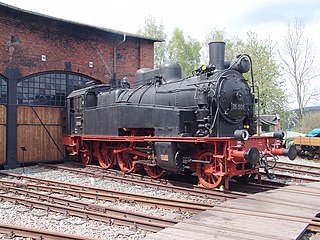History
With the introduction of high speed services on an increasing number of lines Deutsche Reichsbahn required powerful express steam locomotives. They should be capable of a top speed of 150 km/h and of hauling trains of 500 tonnes at 120 km/h, as well as trains of 350 tonnes at 100 km/h up a 5 ‰ inclines. This was more than the existing Class 01 and 03 two-cylinder engines could cope with, having no sufficient power reserves and rough riding qualities at higher speed, Hence the 01.10 was designed with a three-cylinder layout. Furthermore, they were equipped with a streamlined casing to reduce air resistance. Frictional losses were minimized by the use of roller bearings on the driving and coupling rods.
Out of a perceived requirement for 400 locomotives, 204 were initially ordered in 1939 from all major German locomotive manufacturers. However, as a result of the Second World War only 55 were eventually delivered, all of which came from Berliner Maschinenbau.
The Class 01.10 was delivered to the following locomotive sheds ( Bahnbetriebswerke ): Leipzig Hbf West, Berlin Anhalter Bahnhof, Halle, Hamburg-Altona, Hannover-Ost, Bebra, Erfurt P, Dresden-Altstadt, Frankfurt/Oder Pbf Würzburg and Munich as well as the Grunewald Locomotive Research Office. During the war, some of the locomotives were transferred to Breslau and Kattowitz .
In 1944 all engines of the class were moved to western Germany due to the course of the war.
After the Second World War the engines were in a pitiful state. Parts of their streamlined claddings were missing and the boilers, made of steel that was not age-resistant, showed signs of fatigue. On 20 June 1945 the entire class was temporarily withdrawn, having run less than 500,000 km. However, as a result of the post-war locomotive shortage, the class was partially reprieved and several engines with minor damages were overhauled. However the majority of engines remained sidelined until 1949. In that year it was decided that all but one locomotives (the finally retired 01 1067), should be refurbished. The streamlined casings were completely removed and Witte smoke deflectors fitted. The new front view looked unusual for a German steam engine with the smokebox door being cut off in the upper third to provide space for the retained feedwater heater. Only two engines were provided with the usual circular smokebox door.
However, the problem of the boiler being made of non-durable St 47 K steel remained. Because the engines were by far too young to be written off, they received all-new welded high-performance boilers. These were built by Henschel of Kassel between 1953 and 1956 and installed at the Brunswick rmaintenance works, along with a mixing preheater system.
Additionally in 1956 engine 01 1100 received an oil-firing, enhancing its performance considerably. Oil-firing allows for a better control of the grate and could be more easily adapted to respective operating conditions. The engines were therefore more economical than coal-fired locomotives. Working conditions for firemen were also improved. Fuel oil, then available as a waste product, was used for firing. Following their positive experience with 01 1100, the DB decided in 1957 to convert another 33 locomotives of this class to oil-firing.
In 1968, as part of a renumbering scheme to conform with electronic data processing (EDP), the remaining coal-fired locomotives were given the class designation 011 while the oil-fired engines were now class 012.
The locomotives were used on all important main lines until electrification, for example on the Würzburg–Hamburg or Hamm–Hamburg routes. Towards the end they were deployed on the Hamburg–Westerland and Rheine–Norddeich lines.
On 31 May 1975, the remaining engines from Rheine shed ran the last scheduled services, being celebrated by a large number of railway enthusiasts. [1] On 1 June 1975, a special ran from Rheine at 06:50 for the railway families to Emden. It was hauled by 012 061.
Table of withdrawals| Year | Coal-fired
locomotives
at start of year | Oil-fired
locomotives
at start of year | Quantity
withdrawn | Locomotive numbers |
|---|
| 1968 | 20 | 34 | 6 | 011 053/087/094/097, 012 079/089. |
| 1969 | 16 | 32 | 8 | 011 069/078/083/086/090/096/097/099. |
| 1970 | 8 | 32 | 4 | 011 070/093/098, 012 088. |
| 1971 | 5 | 31 | 7 | 011 056/065/091, 012 057/059/076/085. |
| 1972 | 2 | 27 | 10 | 011 072, 012 001/052/054/060/064/053/074/103/105. |
| 1973 | 1 | 18 | 6 | 011 062, 012 058/071/084/092/102. |
| 1974 | 0 | 13 | 5 | 012 068/077/082/101/104. |
| 1975 | 0 | 8 | 8 | 012 055/061/063/066/075/080/081/100. |
|






















